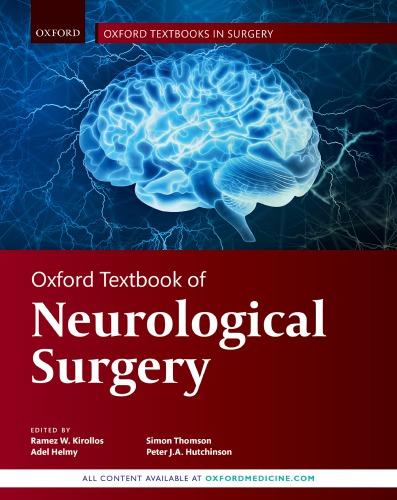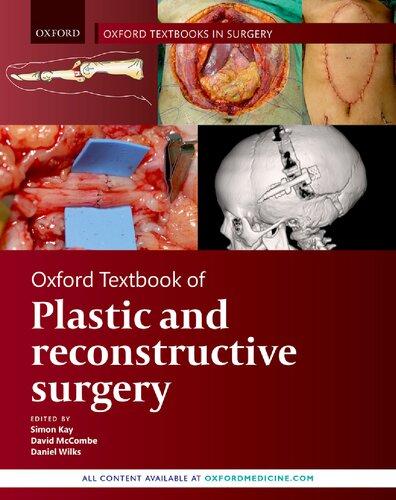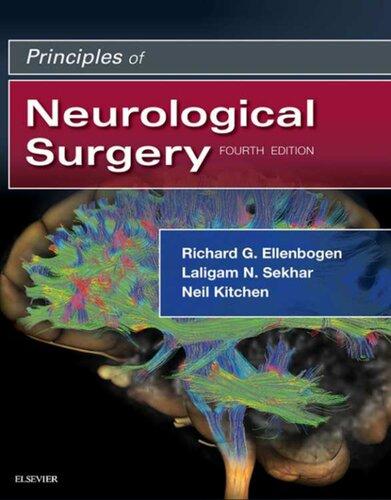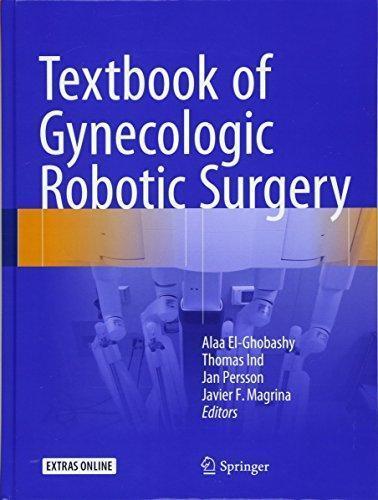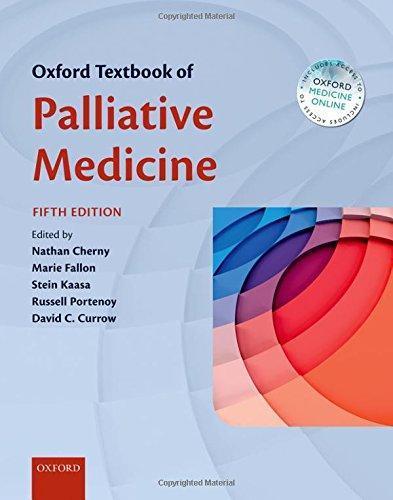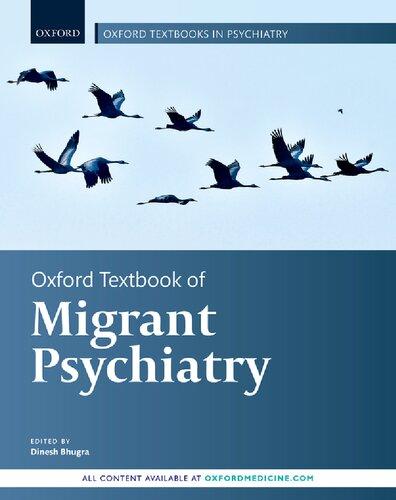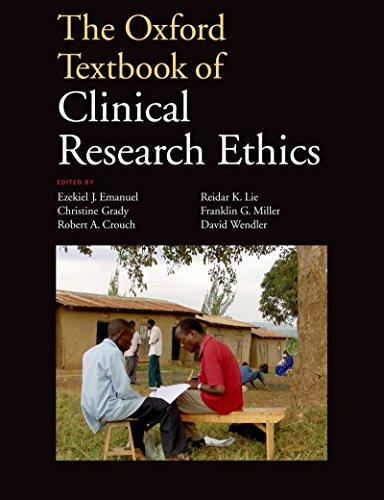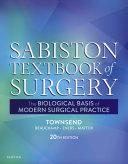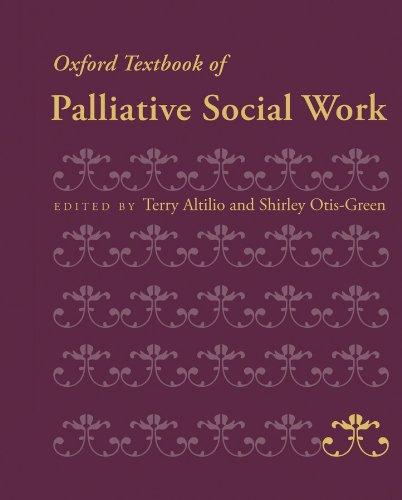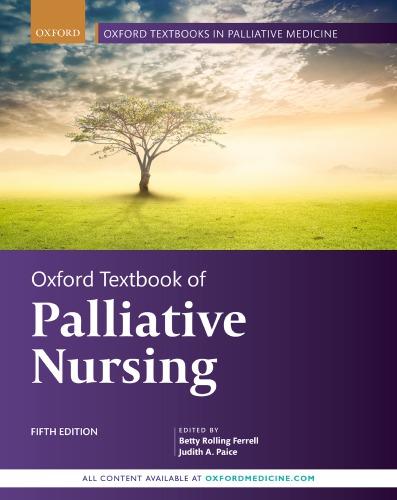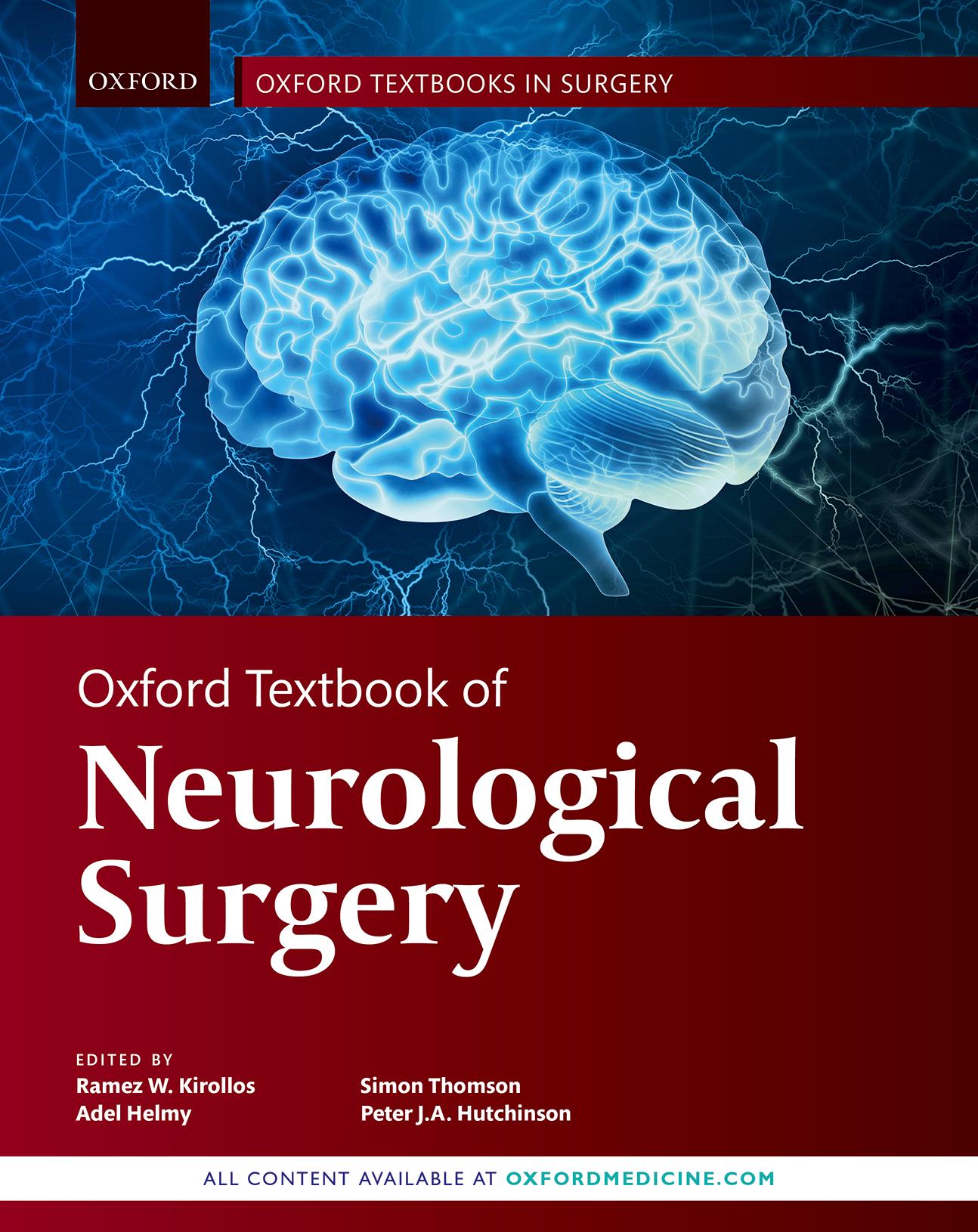Contents
Symbols and abbrevations xv
List of contributors xxi
SECTION 1
Principles of neurological surgery
1. The history of neurosurgery 3
Eleni Maratos and Henry Marsh
2. Clinical assessment 11
Peter Bodkin and Elizabeth Visser
3. Overview of neuroimaging 31
Tomasz Matys, Daniel. J. Scoffings, and Tilak Das
4. The operating theatre environment 45
Neil Kitchen and Jonathan Shapey
5. Perioperative care of the neurosurgical patient 57
Karol P. Budohoski, Alessandro Scudellari, Sylvia Karcheva, and Derek Duane
SECTION
2
Tumours and skull base-intrinsic tumour
6. Low-grade glioma 75
Thomas Santarius, Lorenzo Bello, and Hugues Duffau
7. High-grade gliomas and molecular biology of neurosurgical oncology 89
Stephen J. Price, Harry Bulstrode, and Richard Mair
8. Intracranial metastasis 107
Andrew Brodbelt and Rashed Zakaria
9. Primary central nervous system lymphoma 117
Boon Leong Quah, Thangaraj Munusamy, and Colin Watts
10. Glioneuronal and other epilepsy-associated tumours 129
Matthias Simon and Alexander Grote
11. Radiotherapy and radiosurgery for brain tumours 141
Susan Short
12. Chemotherapy for brain tumours 149
Nicholas F. Brown, Daniel Krell, and Paul Mulholland
13. Surgical techniques in the management of intrinsic tumours 163
Shawn Hervey-Jumper and Mitchel Berger
SECTION 3
Tumours and skull base—extra-axial and skull lesions
14. Meningiomas and haemangiopericytoma (HPC): solitary fibrous tumour (SFT) 175
Harjus S. Birk, Seunggu J. Han, Ramez W. Kirollos, Thomas Santarius, and Michael W. McDermott
15. Chordomas and chondrosarcomas of the skull base 189
Rami O. Almefty and Ossama Al-Mefty
16. Dermoid and epidermoid cysts 197
Andrew McEvoy
17. Esthesioneuroblastoma 205
Georgios Klironomos, Lior Gonen, and Fred Gentili
18. Malignant skull base tumours 213
Benedict Panizza and Adel Helmy
19. Surgical management of tumours of the orbit 221
Joseph D. Chabot, S. Tonya Stefko, and Paul Gardner
20. Skull lesions 229
Giorgio Gioffre and Ivan Tmofeev
21. Surgical management of anterolateral skull base lesions 241
Michael D. Cusimano and Michael P. Meier
SECTION 4
Tumours and skull base—CP angle lesions
22. Schwannomas 255
Tiit Mathiesen, Petter Förander, and David Pettersson
23. Glomus tumours 271
Omar Pathmanaban and Andrew King
24. Surgical management of cerebellopontine angle and petrous lesions 281
Nicholas Hall, Yuval Sufaro, and Andrew H. Kaye
SECTION 5
Tumours and skull base—sellar and suprasellar tumours
25. Pituitary tumours 299
Kanna Gnanalingham, Zsolt Zador, Tara Kearney, Federico Roncaroli, and H. Rao Gattamaneni
26. Craniopharyngioma and Rathke’s cleft cysts 321
Rudolf Fahlbusch, V. Gerganov, and H. Metwali
27. Surgical management of sellar and suprasellar tumours 339
Jayson A. Neil and William T. Couldwell
SECTION 6
Tumours and skull base—posterior fossa
28. Medulloblastoma 353
James Rutka
29. Ependymoma 361
Christopher Chandler
30. Haemangioblastoma 367
Ammar Natalwala and Donald MacArthur
31. Surgical approaches to posterior fossa tumours 375
Jacques J. Morcos, Osaama H. Khan, and Ashish H. Shah
SECTION 7
Tumours and skull base—intraventricular
32. Intraventricular tumours 385
Paul Grundy and Vasileios Apostolopoulos
33. Colloid cyst 393
Asim Sheikh and Paul Chumas
34. Choroid plexus tumours 403
Jonathan Roth, Rina Dvir, and Shlomi Constantini
35. Surgical management of intraventricular lesions 411
Eduardo C. Ribas, Guilherme C. Ribas, and Ramez W. Kirollos
SECTION 8
Tumours and skull base—pineal
36. Pineal tumours 427
Mueez Waqar, Samantha Mills, Conor L. Mallucci, and Michael D. Jenkinson
37. Surgical management of pineal region lesions 439
Christoph M. Woernle, René L. Bernays, and Nicolas de Tribolet
SECTION 9
Tumours and skull base—tumour syndromes
38. Neurophakomatoses 449
Fay Greenway, Frances Elmslie, and Timothy Jones
39. Uncommon brain lesions 461
Yizhou Wan, Hani J. Marcus, and Thomas Santarius
SECTION 10
Neurotrauma and intensive care
40. Epidemiology of head injury and outcome after head injury 475
Nabeel Alshafai and Andrew Maas
41. Pathophysiology of traumatic brain injury 483
John K. Yue, Hansen Deng, Ethan A. Winkler, John F. Burke, Catherine G. Suen, and Geoffrey T. Manley
42. Intensive care management of head injury 497
Matthew A. Kirkman and Martin Smith
43. Surgical management of head injury 509
Hadie Adams, Angelos G. Kolias, Adel Helmy, Peter J.A. Hutchinson, and Randall M. Chesnut
44. Complications of head injury 521
Fardad T. Afshari, Antonio Belli, and Peter C. Whitfield
45. Concussion and sports-related head injury 531
Mark Wilson
SECTION
11
Vascular neurosurgery
46. Normal cerebrovascular physiology and vascular anatomy 539
Diederik O. Bulters and Andrew Durnford
47. The pathophysiology of aneurysms 559
Federico Cagnazzo, Giuseppe Lanzino, and Neal F. Kassell
48. The pathophysiology of subarachnoid haemorrhage 567
Jason McMillen
49. Management of subarachnoid haemorrhage 575
Roberto Rodriguez Rubio, Brian P. Walcott, and Michael T. Lawton
50. Cerebral arteriovenous malformation and dural arteriovenous fistulae 591
Michael Morgan
51. Carotid artery disease and cerebral ischaemia 615
Kieron Sweeney, A. O’Hare, and Mohsen Javadpour
52. Extracranial-intracranial bypass for cerebral ischaemia 627
Mathew R. Guilfoyle and Peter J. Kirkpatrick
53. Giant aneurysms and bypass surgery 633
Mario Teo, Omar Choudhri, and Michael Lawton
54. Spontaneous intracranial haematoma 643
Berk Orakcioglu and Andreas W. Unterberg
55. Cavernomata and angiographically occult lesions 651
Janneke van Beijnum and Hiren Patel
SECTION 12
Spinal surgery—principles
56. Surgical principles in spinal surgery 661
Simon Thomson, Chris Derham, and Senthil Selvanathan
57. Spinal stability 669
Peter R. Loughenbury and Richard M. Hall
58. Spinal physiology 679
Sadaquate Khan, Kevin Tsang, and Lamia Nayeb
59. Medical pathologies of the spinal cord 687
Chris McGuigan, Karen O’Connell, Eavan McGovern, and Iain McGurgan
SECTION 13
Spinal surgery
60. Cervical spinal disease 697
Navin Furtado, Georgios Tsermoulas, and Adikarige Haritha Dulanka Silva
61. Thoracic spinal disease 711
Kieron Sweeney, Catherine Moran, and Ciaran Bolger
62. Lumbar spinal disease 719
Christopher G. Kellett and Matthew J. Crocker
63. Spinal tumours 733
John Brecknell and Boon Leong Quah
64. Vascular lesions of the spinal cord 751
Daniel Walsh
65. Spinal cerebrospinal fluid dynamics 761
Graham Flint
66. Scoliosis and spinal deformity 769
Nigel Gummerson
SECTION 14
Spinal trauma
67. Managing spinal cord trauma 781
Saksith Smithason, Bryan S. Lee, and Edward C. Benzel
68. Cervical spine injuries 789
Calan Mathieson, Chris Barrett, and Likhith Alakandy
69. Thoracic and lumbar spine injuries 801
Bedansh Roy Chaudhary and Shiong Wen Low
70. Spinal cord injury rehabilitation 813
Fahim Anwar, Wail Ahmed, Tamara Tajsic, Damiano G. Barone, and Harry Mee
SECTION 15
Peripheral nerve surgery
71. Electrodiagnostics 827
Alan Forster and Robert Morris
72. Entrapment syndromes 839
Grainne Bourke and Mobin Syed
73. Supraclavicular brachial plexus and peripheral nerve injuries 847
Jonathan Perera and Marco Sinisi
74. Peripheral nerve tumours 855
Rikin Trivedi and Vincent Nga
SECTION 16
Functional neurosurgery
75. Principles of deep brain stimulation 865
Erlick A. C. Pereira, Alexander L. Green, and Tipu Z. Aziz
76. Movement disorders 873
Keyoumars Ashkan and Ismail Ughratdar
77. Spasticity 885
John Goodden, Catherine Hernon, and Brian Scott
78. Pain pathophysiology and surgical management 895
Richard Mannion and Rokas Tamosauskas
79. Cranial nerve vascular compression syndromes 909
Marc Sindou and George Georgoulis
80. Neurosurgical interventions for psychiatric disorders 929
Chris Bervoets, Bart Nuttin, and Loes Gabriëls
SECTION
17
Epilepsy
81. Classification of seizures and epilepsy 935
Andrew McEvoy, Tim Wehner, and Victoria Wykes
82. Epilepsy—diagnosis and assessment 945
Richard Selway
83. Surgical management of epilepsy 957
Johannes Schramm
SECTION 18
Paediatrics
84. Developmental disorders of the brain 971
Colin Ferrie, Daniel Warren, and Atul Tyagi
85. Spinal development and spinal dysraphism 983
Dominic Thompson
86. Craniofaciosynostosis: Syndromic and non-syndromic craniofacial anomalies 993
Federico Di Rocco, Pierre-Aurelien Beuriat, and Eric Arnaud
87. Special considerations in paediatric head and spinal trauma 999
Andrew Kay, Desiderio Rodrigues, Melanie Sharp, and Guirish Solanki
88. Paediatric brain tumours 1009
Jonathan Roth and Shlomi Constantini
89. Paediatric hydrocephalus 1023
Matt Bailey, Chris Parks, and Conor L. Malucci
90. Paediatric neurovascular disorders 1037
Helen G. McCullagh,Tufail Patankar, Tony Goddard, and Atul Tyagi
91. Paediatric epilepsy 1047
Sophia Varadkar and Martin Tisdall
SECTION 19
CSF disorders
92. Hydrocephalus and normal CSF dynamics 1057
Alexander Gamble and Harold Rekate
93. Shunt technology and endoscopic ventricular surgery 1071
Ian K. Pople and William Singleton
94. Normal pressure hydrocephalus 1083
Nicole C. Keong
95. Pseudotumour cerebri syndrome 1093
John D. Pickard and Nicholas Higgins
96. Arachnoid cysts 1101
Ruichong Ma and Stana Bojanic
SECTION 20
Infection
97. Microbiology 1109
Walter A. Hall
98. Cranial infections 1117
Thangaraj Munusamy, Boon Hoe Tan, and Eugene Yang
99. Spinal infection 1129
Nicholas Haden and Edward White
Index 1137
Symbols and abbreviations
Ω omega
α alpha
β beta
δ gamma
µg micrograms
AAA asleep-awake-asleep
AAICH anticoagulation-associated intracerebral haemorrhage
AANS acute and chronic settings
ABC aneurysmal bone cyst
ABI auditory brainstem implants
ABR auditory brainstem responses
AC anterior and posterior commissure (also arachnoid cyst)
ACA anterior cerebral artery
ACD anterior cervical discectomy
ACPP atypical choroid plexus papilloma
ADC apparent diffusion coefficient
ADI atlantodental interval
ADL activities of daily living
ADNFLE autosomal-dominant nocturnal frontal lobe epilepsy
ADPKD autosomal dominant polycystic kidney disease
AED antiepileptic drug
AF atrial fibrillation
AGNIR Advisory Group on Non-ionising Radiation
AICA anterior inferior cerebellar artery
AIDS acquired immunodeficiency syndrome
AIP aryl hydrocarbon receptor-interacting protein
AIS Abbreviation Injury Score (also ASIA Impairment Scale)
ALI acute lung injury
ALIF anterior lumbar interbody fusion
ALL acute lymphatic leukaemia
ALL anterior longitudinal ligament
AP anteroposterior
ASA American Society of Anesthesiologists
ASA anterior spinal artery
ASIA American Spinal Injuries Association
ASPECTS Alberta Stroke Programme Early CT Score
AT anaplastic transformation
ATA anterior temporal artery
ATIII antithrombin III
ATLS advance trauma life support
ATRT atypical teratoid rhabdoid tumour
AVF arteriovenous fistula
AVM arteriovenous malformation
AZ Annulus of Zinn
BAEP brainstem auditory evoked potentials
BBB blood–brain barrier
BECTS benign epilepsy with centrotemporal spikes
BIS bispectral index
BMD bone mineral density
BMI body mass index
BOLD blood oxygen level dependent
BP blood pressure
BRAT Barrow Ruptured Aneurysm Trial
BTF Brain Trauma Foundation
CA cerebral autoregulation
CAA cerebral amyloid angiopathy
CAD coronary artery disease
CAMS cerebrofacial metameric arteriovenous syndromes
CAPECTH craniectomy-associated progressive extra-axial collections with treated hydrocephalus
CAR cerebral autoregulation
CAS carotid angioplasty and stenting
CBF cerebral blood flow
CBV cerebral blood volume
CCA common carotid artery
CCM cerebral cavernous malformations
CDC Centers for Disease Control
CDK cyclin dependent kinases
CFAM cerebral function analysing monitor
CHF congestive heart failure
CHLA Children’s Hospital Los Angeles
CISS Constructive Interference in Steady State
CM cavernous malformations
CM central myelin
CMAP compound motor action potential
CMRO2 cerebral metabolic rate of oxygen consumption
CN cranial nerve
CNS central nervous system (also Congress of Neurological Surgeons)
COPD chronic obstructive pulmonary disease
COSS Carotid Occlusion Surgery Study
CPA cerebellopontine angle
CPC choroid plexus carcinoma
CPH choroid plexus hyperplasia
CPP cerebral perfusion pressure (also choroid plexus papilloma)
CPP choroid plexus papilloma
CPT choroid plexus tumour
CRF corticotrophin factor
CRH corticotrophin-releasing hormone
CRP C-reactive protein
CRPS complex regional pain syndrome
CRW Cosman-Roberts-Wells
CSF cerebrospinal fluid
CSW cerebral salt wasting
CSWS cerebral salt wasting syndrome
CT computed tomographic
CTA computed tomography angiography
CTP cerebellar tonsillar prolapse
CTS carpal tunnel syndrome
CTV clinical target volume
CUSA cavitron ultrasonic surgical aspirator
DBS deep brain stimulation
DEBS direct electrical brain stimulation
DES drug-eluting stents
DESD detrusor external sphincter dyssynergia
DEXA dual-energy X-ray absorptiometry
DI diabetes insipidus
DIND delayed ischaemic neurological deficits
DISH diffuse idiopathic skeletal hyperostosis
DLGG diffuse low-grade gliomas
DNP dynamic nuclear polarization
DNT dysembryoplastic neuroepithelial tumours
DPG diffuse pontine glioma
DRG dorsal root ganglion
DRIFT Drainage, Irrigation and Fibrinolytic Therapy
DSA digital subtraction angiography
DSB double-strand break
DTI diffusion tensor imaging
DVA deep venous anomaly
DVA developmental venous anomaly
DVT deep vein thrombosis
DWI diffusion-weighted imaging
DWMH deep white matter hyperintensities
DXA dual X-ray absorbitometery
ECA external carotid artery
ECG electrocardiogram
ECoG electrocorticography
EDF elongation derotation flexion
EDL extensor digitorum longus
EEA endoscopic endonasal approach
EEG electroencephalography
EGFR epidermal growth factor receptor
EIEE early infantile onset epileptic encephalopathies
ELISA enzyme-linked immunosorbent assay
EMA epithelial membrane antigen
EMG electromyography
ENT ear, nose, and throat
EOIS early onset idiopathic scoliosis
EOR extent of resection
EORTC European Organization for Research and Treatment of Cancer
EP evoked potential
EPC epilepsia partialis continua
ES ethmoid sinus
ERG Electroretinogram
ES Ewing’s sarcoma
ESO European Stroke Organisation
ESR erythrocyte sedimentation rate
ET essential tremor
ETT endotracheal tube
ETV endoscopic third ventriculostomy
EVD external ventricular drain
EZ epileptogenic zone
FA fractional anisotropy
FCD focal cortical dysplasias
FCU flexor carpi ulnaris
FD fibrous dysplasia
FDA Food and Drug Administration
FEF frontal eye field
FES functional electric stimulation
FFP fresh frozen plasma
FGN French Glioma Network
FIESTA fast imaging in steady state
FIPA familial isolated pituitary adenoma
FLAIR fluid attenuated inversion recovery
FLE frontal lobe epilepsy
FM Foramen of Monro
FSH follicle-stimulating hormone
FSU functional spinal unit
FTT failure to thrive
FV flow velocities
FZS fronto-zygomatic suture
GABA gamma aminobutyric acid
GAF Global Assessment of Function
GCS Glasgow Coma Scale
GCT germ cell tumours (also granular cell tumour)
GFAP glial fibrillary acid protein
GFR glomerular filtration rate
GH growth hormone
GHIH growth hormone-inhibiting hormone
GHRH growth hormone release hormone
GI gastrointestinal
GMFM Gross Motor Function Measure
GSPN greater superficial petrosal nerve
GTCS generalized tonic-clonic seizures
GTR gross total resection
GTV gross tumour volume
GW gliadel wafers
H&E haematoxylin and eosin
HBO hyperbaric oxygen
HDDST high-dose dexamethasone suppression tests
HGG high-grade glioma
HHT hereditary haemorrhagic telangiectasia
HIF hypoxia inducible factor
HIFU high-intensity focused ultrasound
HIV human immunodeficiency virus
HLA human leukocyte antigen
HMSN hereditary motor, and sensory neuropathy
HO heterotrophic ossification
HPA hypothalamic-pituitary axis
HPC haemangiopericytoma
HR homologous recombination
HRQOL health-related quality of life
HS hippocampal sclerosis
HS hypertonic saline
HSV herpes simplex virus
HU Hounsfield units
IA intra-arterial
IAC internal auditory canal
IAM internal auditory meatus
IBE International Bureau for Epilepsy
ICA inferior cerebellar artery (also internal carotid artery)
ICA internal carotid arteries
ICBP infraclavicular brachial plexus
ICE ifosfamide, carboplatin, and etoposide
ICH intracerebral haemorrhage
ICP intracranial pressure
ICU intensive care unit
IFOF inferior fronto-occipital fasciculus
IJV internal jugular vein
ILAE International League Against Epilepsy
IO inferior oblique
IOF inferior orbital fissure
IOM Intraoperative monitoring
IPG implantable pulse generator
IPG implanted battery-operated pulse generators
IPSS inferior petrosal vein sampling
IR inferior rectus
IR iterative reconstruction
ISAT International Subarachnoid Aneurysm Trial
ISCoS International Spinal Cord Society
ISNCSCI International Standards for Neurological Classification of Spinal Cord Injury
ITB intrathecal baclofen
IVC inferior vena cava
IVP intraventricular pressure
JET Japanese EC-IC Bypass Trial
KOLT Kendrick object learning test
kPa kilopascal
KPS Karnofsky Performance Status
LCH Langerhans cell histiocytosis
LDD L’hermitte-Duclos disease
LDDST low-dose dexamethasone suppression test
LDL low-density lipoprotein
LDM limited dorsal myeloschisis
LFS Li-Fraumeni syndrome
LG lacrimal gland
LGG low-grade glioma
LH luteinizing hormone
LINAC linear accelerator
LMN lower motor neuron
LMWH low molecular weight heparin
LOC level of consciousness
LOH loss of heterozygosity
LOIS late onset idiopathic scoliosis
LOR line of response
LOVA longstanding overt ventriculomegaly in adults
LP levator palpebrae
LP lumbar puncture
LR lateral rectus
LR Lindegaard ratio
LSO lumbar sacral orthosis
LSR lateral spread responses
MAC minimal alveolar concentration
MAP mean arterial pressure
MC Meckel cave
MCA middle cerebral artery
MCD malformation of cortical development
MDT multidisciplinary team
MEG magnetoencephalography
MEP minimally endoscopic procedures
MEP motor evoked potential
MHC major histocompatibility complex
MI myocardial infarction
MIP maximum intensity projection
MIT minimally invasive techniques
MLF medial longitudinal fasciculus
MM multiple myeloma
MMD moya moya disease
MMS moya moya syndrome
MMSE mini-mental state examination
MND motor neurone disease
MOG myelin oligodendrocyte glycoprotein
MPBT malignant paediatric brain tumours
MPNST malignant peripheral nerve sheath tumours
MR magnetic resonance
MR medial rectus
MRA magnetic resonance angiography
MRA MR-angio
MRC Medical Research Council
MRI magnetic resonance imaging
MRM magnetic resonance myelography
MRN magnetic resonance neurography
MRS magnetic resonance spectroscopy
MRSA methicillin-resistant Staphylococcus aureus
MRV magnetic resonance venography
MS multiple sclerosis
MSH melanocyte-stimulating hormone
MTG middle temporal gyrus
MTLE mesial temporal lobe epilepsy
MTT mean transit time
MUAP motor unit action potential
MVA motor vehicle accidents
MVC motor vehicle collisions
MVD microsurgical vascular decompression
Na+ sodium
NAA N-acetyl aspartate
NASCIS National Acute Spinal Cord Injury Studies
NCS nerve conduction studies
NeuN neuronal nuclei
NFPA non-functioning pituitary adenomas
NHEJ non-homologous end-joining
NHL non-Hodgkin’s lymphoma
NICE National Institute of Clinical Excellence
NIRS near infrared spectroscopy
NLI neurological level of injury
NMDA N-methyl-D-aspartate
NMS non-motor symptoms
NOAC new oral anticoagulants
NOS not otherwise specified
NPH normal pressure hydrocephalus
NPSA National Patient Safety Agency
NPUAP National Pressure Ulcer Advisory Panel
NSAID non-steroidal anti-inflammatory drug
OC optic canal
OCR optico-carotid recesses
OCT optical coherence tomography
ODI Oswestry Disability Index
OEF oxygen extraction fraction
OLE occipital lobe epilepsy
OLF ossification of the ligamentum flavum
ON optic nerve
OPG optic pathway glioma
OPLL ossification of the posterior longitudinal ligament
OS overall survival
OSA obstructive sleep apnoea
PA pilocytic astrocytoma
PAR protease-activated receptors
PBI penetrating brain injury
PBT paediatric brain tumour
PCA posterior cerebral artery
PCC prothrombin complex concentrate
PCNSL primary central nervous system lymphoma
PCR polymerase chain reaction
PCV procarbazine, CCNU, vincristine
PD Parkinson’s disease (also proton density)
PDGFR platelet-derived growth factor receptor
PE preoperative embolization
PE pulmonary embolism
PEDI Pediatric Evaluation of Disability Inventory
PEEK poly-ether-ether-ketone
PEEP positive end-expiratory pressure
PEG percutaneous endoscopic gastrostomy
PET positron emission tomography
PFO patent foramen ovale
PFS progression-free survival
PI pelvic incidence
PICA posterior inferior cerebellar artery
PIH prolactin-inhibiting hormone
PIOL primary intraocular lymphoma
PLL posterior longitudinal ligament
PML progressive multifocal leukoencephalopathy
PNET primitive neuroectodermal tumour
PONV postoperative nausea and vomiting
PPTID pineal parenchymal tumours of intermediate differentiation
PRH prolactin-releasing hormone
PSA posterior spinal arteries
PSO pedicle subtraction osteotomy
PT pelvic tilt (also prothrombin time)
PTA pure-tone audiogram
PTH post-traumatic hydrocephalus
PTPR papillary tumour of the pineal region
PTS post-traumatic seizures
PTSD post-traumatic stress disorder
PTT partial thromboplastin time
PTV planning target volume
PVA poly-vinyl-alcohol
QoL quality of life
QOLIBRI Quality of Life after Brain Injury
RA rheumatoid arthritis
RANKL receptor activator of NF-KB ligand
RANO Response Assessment in Neuro-Oncology
RAPD relative afferent pupil defect
RCC renal cell carcinoma
RCN Rare Cancer Network
RCT randomized clinical trials
REM rapid eye movement
REZ root entry zone
RF rheumatoid factor
RNFL retinal nerve fibre layer
RT radiation therapy
RT resistance in the tube
RVAD rib-vertebral-angle difference
SAH subarachnoid haemorrhage
SARS sacral anterior nerve root stimulator
SBP supraclavicular brachial plexus
SCA superior cerebellar artery
SCA superior cerebellar artery
SCAVM spinal cord arteriovenous malformations
SCI spinal cord injury
SCID severe-combined immunodeficiency disease
SCM strap muscles
SCO spindle cell oncocytoma
SCPP spinal cord perfusion pressure
SDAVF spinal dural arteriovenous fistula
SDR selective dorsal rhizotomy
SDS speech discrimination score
SEA spinal epidural abscess
SEEG stereoencephalography
SEER Surveillance Epidemiology and End Results
SEGA subependymal giant cell astrocytomas
SEP Somatosensory evoked potential
SESH spontaneous epidural spinal haemorrhage
SFT solitary fibrous tumour
SGCT subependymal giant cell tumour
SIADH syndrome of inappropriate antidiuretic hormone
SIVMS Scottish Intracranial Vascular Malformation Study
SLE systemic lupus erythematous
SLF superior longitudinal fasciculus
SMA supplementary motor area
SNAP sensory nerve action potential
SNO Society for NeuroOncology
SNUC sinonasal undifferentiated carcinoma
SO superior oblique
SOF superior orbital fissure
SOM spheno-orbital meningiomas
SOV superior ophthalmic vein
SPECT single photon emission computed tomography
SPES single pulse electrical stimulation
SPN selective peripheral neurotomy
SPV superior petrosal venous
SR superior rectus
SSFP steady state free precession
SSI surgical site infection
SSMA supplementary sensorimotor area
SSS superior sagittal sinus
SST Short Synacthen Test
STA superficial temporal artery (also superior thyroid artery)
STASCIS Surgical Treatment of Acute Spinal Cord Injury Study
STG superior temporal gyrus
STIR short tau inversion recovery
STR subtotal resection
SUDEP sudden unexplained death in epilepsy
SUNCT short-lived, unilateral neuralgic headache with conjunctival injection and tearing
SVA sagittal vertical axis
SVM spinal vascular malformation
SWI susceptibility weighted imaging
TBI traumatic brain injury
TCD transcranial Doppler
TCGA The Cancer Genome Atlas
TF tissue factor
TFPI tissue factor pathway inhibitor
TIVA total intravenous anaesthesia
TLE temporal lobe epilepsy
TLSO thoracolumbar sacral orthosis
TMG transmural pressure gradient
TMS tumefactive multiple sclerosis
TN trigeminal neuralgia
TOF time of flight
TORCH Toxoplasmosis, Other (syphilis, varicella-zoster, parvovirus B19), Rubella, Cytomegalovirus (CMV), and Herpes infections
TREZ trigeminal root entry zone
TRH thyroid-releasing hormone (also thyrotropinreleasing hormone)
TSC tuberous sclerosis complex
TSH thyroid-stimulating hormone
TT thrombin time
TTM targeted temperature management
TTP time to peak
TZ transitional zone
UH unfractionated heparin
UMN upper motor neuron
UMNL upper motor neurone lesions
VA vertebral artery
VAD ventricular access device
VAE venous air embolism
VASO vascular space occupancy
VBA vertebrobasilar artery
VDE velocity of diametric expansion
VEGF vascular endothelial growth factor
VEP visual evoked potential
VGAM vein of Galen malformations
VGPN vago-glossopharyngeal neuralgia
VHL Von Hippel-Lindau
VMAT volumetric modulated arc therapy
VNS vagus nerve stimulation
VP vancomycin powder
VP ventriculoperitoneal
VRE vancomycin-resistant enterococci
VS vestibular schwannoma (also ventral striatum)
VTE venous thromboembolism
vWF von Willebrand factor
WBC white blood cell
WBRT whole-brain radiation therapy
WFNS World Federation of Neurosurgical Societies
WFSBP World Federation of Societies of Biological Psychiatry
WHO World Health Organization
YBOCS Yale-Brown Obsessive-Compulsive Scale
Contributors
Hadie Adams Cambridge University Hospitals
NHS Foundation Trust, Cambridge, UK
43: Surgical management of head injury
Fardad T. Afshari Cambridge University Hospitals
NHS Foundation Trust, Cambridge, UK
44: Complications of head injury
Wail Ahmed Consultant, Spinal Cord Injuries in Stoke Mandeville Hospital, Aylesbury, Buckinghamshire, UK
70: Spinal cord injury rehabilitation
Likhith Alakandy Consultant Neurosurgeon, Southern General Hospital, Glasgow, UK
68: Cervical spine injuries
Kieren Allinson Department of Pathology, Addenbrooke’s Hospital, Cambridge, UK
Ossama Al-Mefty UAMS Medical Center, Little Rock, AK, USA; and Department of Neurosurgery, Brigham and Women’s Hospital, Boston MA, USA
15: Chordomas and chondrosarcomas of the skull base
Rami O. Almefty Department of Neurosurgery, Temple University, Philadelphia, PA, USA
15: Chordomas and chondrosarcomas of the skull base
Nabeel Alshafai Assistant Professor, Neurosurgery, Antwerp, Belgium
40: Epidemiology of head injury and outcome after head injury
Fahim Anwar Consultant in Rehabilitation Medicine, Department of Rehabilitation Medicine, Cambridge University Hospital NHS, Foundation Trust, Cambridge, UK
70: Spinal cord injury rehabilitation
Vasileios Apostolopoulos University Hospital Southampton NHS Foundation Trust, Southampton, UK
32: Intraventricular tumours
Eric Arnaud Department of Pediatric Neurosurgery, Necker-Enfants Malades Hospital, Paris, France
86: Spinal development and spinal dysraphism
Keyoumars Ashkan Kings College Hospital, London, UK
76: Movement disorders
Tipu Aziz The Nuffield Department of Clinical Neurosciences, University of Oxford, Oxford, UK
75: Principles of deep brain stimulation
Matt Bailey Consultant Neurosurgeon, Salford Royal NHS Foundation Trust, Salford, UK
89: Paediatric hydrocephalus
Damiano G. Barone Department of Neurosurgery, Addenbrooke’s Hospital, Cambridge, UK
70: Spinal cord injury rehabilitation
Chris Barrett Consultant Neurosurgeon, Southern General Hospital, Glasgow, UK
68: Cervical spine injuries
Janneke van Beijnum Salford Royal NHS Foundation Trust, Salford, UK
55: Cavernoma and angiographically occult lesions
Antonio Belli Reader in Neurotrauma, School of Clinical and Experimental Medicine, College of Medical and Dental Sciences, University of Birmingham, Birmingham, UK
44: Complications of head injury
Lorenzo Bello Associate Professor Neurosurgery, University of Milan, Italy
6: Low-grade glioma
Edward Benzel Chairman and Spinal Surgeon, Cleveland Clinic, OH, USA
67: Managing spinal cord trauma
Mitchel Berger Department of Neurological Surgery, University of California, San Francisco, CA, USA
13: Surgical techniques in the management of intrinsic tumours
René Bernays Department of Neurosurgery, Klinik Hirslanden, Zurich, Switzerland
37: Surgical management of pineal region lesions
Chris Bervoets Psychiatrist, UZ Leuven, Leuven, Belgium
80: Neurosurgical interventions for psychiatric disorders
Pierre-Aurelien Beuriat Hopital Chu de Lyon, Lyon, France
86: Spinal development and spinal dysraphism
Harjus Birk Department of Neurological Surgery, University of California, San Francisco, CA, USA
14: Meningiomas and haemangiopericytoma (HPC)—solitary fibrous tumour (SFT)
Peter Bodkin Aberdeen Royal Infirmary, Scotland, UK
2: Clinical assessment
Stana Bojanic Department of Neurosurgery, Oxford University Hospitals NHS Foundation Trust, Oxford, UK
96: Arachnoid cysts
Ciaran Bolger College of Surgeons, Dublin, Ireland
61: Thoracic spinal disease
Grainne Bourke Leeds General Infirmary, Clarendon Way, Leeds, UK
72: Entrapment syndromes
John Brecknell Queen’s Hospital, Romford, London, UK
63: Spinal tumours
Andrew Brodbelt The Walton Centre NHS Foundation Trust, Liverpool, UK
8: Intracranial metastasis
Nicholas Brown University College Hospitals, London, UK
12: Chemotherapy for brain tumours
Karol P. Budohoski Neurosurgical Specialist Registrar, Cambridge University Hospital NHS Trust, Department of Neurosurgery, Addenbrooke’s Hospital, Cambridge University Hospitals, Cambridge, UK
5: Perioperative care of the neurosurgical patient
Harry Bulstrode Clinical Lecturer in Neurosurgery, Neurosurgery Division, Department of Clinical Neurosciences, Cambridge Biomedical Campus, Cambridge, UK
7: High-grade gliomas and molecular biology of neurosurgical oncology
Diederik O. Bulters Department of Neurosurgery, Wessex Neurological Centre, Southampton General Hospital, Southampton, UK
46: Normal cerebrovascular physiology and vascular anatomy
John F. Burke Resident Physician, Department of Neurological Surgery, University of California, San Francisco, CA, USA
41: Pathophysiology of traumatic brain injury
Federico Cagnazzo Università di Pisa, Pisa, Italy
47: The pathophysiology of aneurysms
Joseph D. Chabot Department of Neurological Surgery, University of Pittsburgh, PA, USA
19: Surgical management of tumours of the orbit
Christopher Chandler Consultant Adult and Paediatric Neurosurgeon, King’s College Hospital, London, UK
29: Ependymoma
Bedansh Roy Chaudhary Cambridge University Hospitals NHS Foundation Trust, Cambridge, UK
69: Thoracic and lumbar spine injuries
Randall M. Chesnut Professor, Neurological Surgery; Professor, Orthopedics and Adjunct Professor, Global Health, Harborview Medical Center, Department of Neurosurgery, Seattle, WA, USA
43: Surgical management of head injury
Omar Choudhri Assistant Professor, Department of Neurosurgery, University of Pennsylvania, PA, USA
53: Giant aneurysms and bypass surgery
Paul Chumas Consultant in Neurosurgery, Leeds Teaching Hospitals, Leeds, UK
33: Colloid cyst
Shlomi Constantini Director, Department of Pediatric Neurosurgery, Dana Children’s Hospital, Tel Aviv Sourasky Medical Center, Sackler Faculty of Medicine, Tel Aviv University, Tel Aviv, Israel
34: Choroid plexus tumours; 88: Paediatric brain tumours
William T. Couldwell Professor, Neurosurgery, University of Utah, UT, USA
27: Surgical management of sellar and suprasellar tumours
Matt Crocker Consultant Neurosurgeon, St George’s Hospital, London, UK
62: Lumbar spinal disease
Michael D. Cusimano Division of Neurosurgery, University of Toronto, ON, Canada; Keenan Research Centre for Biomedical Science, The Li Ka Shing Knowledge Institute, St. Michael’s Hospital, Toronto, ON, Canada
21: Surgical management of anterolateral skull base lesions
Tilak Das Addenbrooke’s Hospital, Cambridge University Hospitals, Cambridge, UK
3: Overview of neuroimaging
Hansen Deng Resident Physician, Department of Neurological Surgery, University of Pittsburgh Medical Center, Pittsburgh, PA, USA
41: Pathophysiology of traumatic brain injury
Chris Derham Consultant Neurosurgeon, Leeds General Infirmary, Leeds, UK
56: Surgical principles in spinal surgery
Federico Di Rocco The Hôpital Necker Enfants Malades, Paris, France
86: Spinal development and spinal dysraphism
Derek Duane Consultant in Neuroanaesthesia and Neurointensive Care, Cambridge University Hospital NHS Trust, Department of Anaesthesia, Addenbrooke’s Hospital, Cambridge, UK
5: Perioperative care of the neurosurgical patient
Hugues Duffau Institute for Neurosciences of Montpellie, France
6: Low-grade glioma
Andrew Durnford Department of Neurosurgery, Wessex Neurological Centre, Southampton General Hospital, Southampton, UK
46: Normal cerebrovascular physiology and vascular anatomy
Rina Dvir Department of Pediatric Hemato-Oncology, Dana Children’s Hospital, Tel-Aviv Medical Center, Tel-Aviv University, Tel-Aviv, Israel
34: Choroid plexus tumours
Frances Elmslie South West Thames Regional Genetics Service, St George’s University Hospitals NHS Foundation Trust, London, UK
38: Neurophakomatoses
Rudolf Fahlbusch International Neuroscience Institute (INI), Hannover, Germany
26: Craniopharyngioma and Rathke’s cleft cysts
Colin Ferrie Department of Paediatric Neurology, Leeds General Infirmary, Leeds, UK
84: Developmental disorders of the brain
Graham Flint Consultant Neurosurgeon, Queen Elizabeth Hospital, Birmingham, UK
65: Spinal cerebrospinal fluid dynamics
Petter Förander Karolinska Institute, Stockholm, Sweden
22: Schwannomas
Alan Forster Consultant Clinical Neurophysiologist, Aberdeen Royal Infirmary, Scotland, UK
71: Electrodiagnostics
Navin Furtado Queen Elizabeth Hospital, Birmingham, UK
60: Cervical spinal disease
Alexander Gamble Bedford, New Hampshire, USA
92: Hydrocephalus and normal CSF dynamics
Paul Gardner Department of Neurological Surgery, University of Pittsburgh, PA, USA
19: Surgical management of tumours of the orbit
H. Rao Gattamaneni Consultant in Clinical oncology, Christie Foundation Trust, Manchester, UK
25: Pituitary tumours
Fred Gentili Division of Neurosurgery, University of Toronto, ON, Canada
17: Esthesioneuroblastoma
George Georgoulis Department of Neurosurgery, General Hospital of Athens “Gennimatas”, Athens, Greece
79: Cranial nerve vascular compression syndromes
V. Gerganov Consultant Neurosurgeon, Department of Neurosurgery, International Neuroscience Institute, Hannover; and Associate Professor, Hannover Medical School, Germany
26: Craniopharyngioma and Rathke’s cleft cysts
Giorgio Gioffre Treviso, Italy
20: Skull lesions
Kanna Gnanalingham Salford Royal NHS Foundation Trust, UK
25: Pituitary tumours
Tony Goddard Consultant Interventional Neuroradiologist, Leeds General Infirmary, Leeds, UK
90: Paediatric neurovascular disorders
Lior Gonen Division of Neurosurgery, Department of Surgery, University of Toronto, Canada. Department of Neurosurgery, Aurora Neuroscience Innovation Institute, Aurora St. Luke’s Medical Center, Milwaukee, Wisconsin
17: Esthesioneuroblastoma
John Goodden Consultant Neurosurgeon (Adult & Paediatric), Leeds General Infirmary, Leeds, UK
77: Spasticity
Alex Green The Nuffield Department of Clinical Neurosciences, University of Oxford, UK
75: Principles of deep brain stimulation
Fay Greenway Atkinson Morley Department of Neurosurgery, St George’s University Hospitals
NHS Foundation Trust, London, UK
38: Neurophakomatoses
Alexander Grote Department of Neurology, University of Bonn, Bonn, Germany
10: Glioneuronal and other epilepsy-associated tumours
Paul Grundy Department of Neurosurgery, Wessex Neurological Centre, University Hospital Southampton NHS Foundation trust, UK
32: Intraventricular tumours
Mathew Guilfoyle Department of Neurosurgery, Addenbrookes’s NHS Trust, Cambridge, UK
52: Extracranial-intracranial bypass for cerebral ischaemia
Nigel Gummerson Consultant in Orthopaedic Trauma, Leeds General Infirmary, Leeds, UK
66: Scoliosis and spinal deformity
Nicholas Haden Plymouth Hospitals NHS Trust, Plymouth, UK
99: Spinal infection
Nicholas Hall Surgeon, Royal Melbourne Hospital Academic Centre, Parkville, VIC, Australia
24: Surgical management of cerebellopontine angle and petrous lesions
Richard M. Hall Professor of Spinal Biomechanics, School of Mechanical Engineering, University of Leeds, Leeds, UK
57: Spinal stability
Walter Hall Professor of Neurosurgery, Upstate Medical University, Syracuse, NY, USA
97: Microbiology
Seunggu J. Han Department of Neurological Surgery, University of California, San Francisco, CA, USA
14: Meningiomas and haemangiopericytoma (HPC)—solitary fibrous tumour (SFT)
Adel Helmy University Lecturer Neurosurgery, University of Cambridge, UK/Honorary Consultant Neurosurgeon, Addenbrooke’s Hospital, Cambridge, UK
18: Malignant skull base tumours; 43: Surgical management of head injury
Catherine Hernon Consultant in Plastic & Reconstructive Surgery, Leeds General Infirmary, Leeds, UK
77: Spasticity
Shawn Hervey-Jumper Associate Professor, Neurosurgery, University of California San Francisco, USA
13: Surgical techniques in the management of intrinsic tumours
Nicholas Higgins Department of Radiology, Addenbrooke’s Hospital, Cambridge, UK
95: Pseudotumour cerebri syndrome
Peter J.A. Hutchinson Professor of Neurosurgery, University of Cambridge, Cambridge, UK
43: Surgical management of head injury
Mohsen Javadpour Beaumont Hospital, Dublin, Ireland
51: Carotid artery disease and cerebral ischaemia
Michael D. Jenkinson Department of Neurosurgery, University of Liverpool, Liverpool, UK
36: Pineal tumours
Timothy Jones Department of Neurosurgery, St George’s University Hospital Foundation Trust, London, UK
38: Neurophakomatoses
Sylvia Karcheva Consultant in Neuroanaesthesia, Cambridge University Hospital NHS Trust, Department of Anaesthesia, Addenbrooke’s Hospital, Cambridge University Hospitals, Cambridge, UK
5: Perioperative care of the neurosurgical patient
Neal Kassell University of Virginia School of Medicine, Charlottesville, VA, USA
47: The pathophysiology of aneurysms
Andrew Kay Consultant Paediatric Neurosurgery, Queen Elizabeth Hospital, Birmingham, UK
87: Special considerations in paediatric head and spinal trauma
Andrew H. Kaye Surgeon, Royal Melbourne Hospital Academic Centre, Parkville, VIC, Australia
24: Surgical management of cerebellopontine angle and petrous lesions
Tara Kearney Salford Royal NHS Foundation Trust, UK
25: Pituitary tumours
Chris Kellett University College London Hospitals, London, UK
62: Lumbar spinal disease
Nicole C. Keong Consultant Neurosurgeon, National Neuroscience Institute and Duke-NUS Medical School, Singapore
94: Normal pressure hydrocephalus
Osaama H. Khan Department of Neurological Surgery, Northwestern University
31: Surgical approaches to posterior fossa tumours
Sadaquate Khan Department of Clinical Neurosciences, Western General Hospital, Edinburgh, Scotland, UK
58: Spinal physiology
Andrew King Manchester Skull Base Unit, Department of Neurosurgery, Manchester Centre for Clinical Neurosciences, Salford Royal Hospital, University of Manchester, Manchester, UK
23: Glomus tumours
Matthew A. Kirkman Specialty Registrar in Neurosurgery and Honorary Fellow in Neurocritical Care; and The National Hospital for Neurology and Neurosurgery, University College London Hospitals NHS Foundation Trust, Queen Square, London, UK
42: Intensive care management of head injury
Peter Kirkpatrick Department of Neurosurgery, Addenbrookes’s NHS Trust, Cambridge, UK
52: Extracranial-intracranial bypass for cerebral ischaemia
Ramez W. Kirollos Consultant Neurosurgeon, Addenbrooke’s Hospital, Cambridge, UK; Department of Neurological Surgery, University of California, San Francisco, CA, USA
14: Meningiomas and haemangiopericytoma (HPC)—solitary fibrous tumour (SFT); 35: Surgical management of intraventricular lesions
Neil Kitchen National Hospital for Neurology and Neurosurgery, University College London Hospital NHS Foundation Trust, London, UK
4: The operating theatre environment
Georgios Klironomos Division of Neurosurgery, Department of Surgery, University of Toronto, Canada
17: Esthesioneuroblastoma
Angelos G. Kolias Clinical Lecturer Neurosurgery, Addenbrooke’s Hospital, Cambridge, UK
43: Surgical management of head injury
Daniel Krell University College Hospitals, London, UK
12: Chemotherapy for brain tumours
Giuseppe Lanzino Mayo Clinic, Rochester, MN, USA
47: The pathophysiology of aneurysms
Michael Lawton Department of Neurosurgery, Barrow Neurological Institute, Phoenix, AZ, USA
49: Management of subarachnoid haemorrhage; 53: Giant aneurysms and bypass surgery
Bryan Lee Neurosurgeon, Barrow Neurological Institute, Phoenix, AZ
67: Managing spinal cord trauma
Boon Leong Quah Department of Neurosurgery, Queen’s Hospital, Romford, London, UK and Division of Neurosurgery, Khoo Teck Puat Hospital, Singapore
9: Primary central nervous system lymphoma; 63: Spinal tumours
Shiong Wen Low Consultant Neurosurgeon, National University Hospital and Ng Teng Fong General Hospital, Singapore; and Associate Professor, Department of Surgery, National University of Singapore
69: Thoracic and lumbar spine injuries
Peter Loughenbury Leeds Teaching Hospital NHS Trust, Leeds, UK
57: Spinal stability
Ruichong Ma Department of Neurosurgery, Oxford University Hospitals NHS Foundation Trust, Oxford, UK
96: Arachnoid cysts
Andrew Maas University of Antwerp and Antwerp University Hospital, Department of Neurosurgery, Antwerp, Belgium
40: Epidemiology of head injury and outcome after head injury
Richard Mair Clinical Lecturer in Neurosurgery, Neurosurgery Division, Department of Clinical Neurosciences, Cambridge Biomedical Campus, Cambridge, UK
7: High-grade gliomas and molecular biology of neurosurgical oncology
Conor L. Mallucci Department of Paediatric Neurosurgery, Alder Hey Children’s Hospital, Liverpool, UK
36: Pineal tumours; 89: Paediatric hydrocephalus
Geoffrey T. Manley Professor and Vice Chair, Department of Neurological Surgery, University of California San Francisco, San Francisco, CA, USA
41: Pathophysiology of traumatic brain injury
Richard Mannion Department of Neurosurgery, Addenbrooke’s Hospital, Cambridge, UK
78: Pain pathophysiology and surgical management
Hani Marcus Faculty of Medicine, Department of Surgery and Cancer, Imperial College London, London, UK
39: Uncommon brain lesions
Henry Marsh Senior Consultant Neurosurgeon, St George’s Hospital, London, UK
1: The History of Neurosurgery
Eleni Maratos Consultant Neurosurgeon, King’s College Hospital, London, UK
1: The History of Neurosurgery
Tiit Mathiesen Department of Clinical Neuroscience, Karolinska Institutet, Stockholm, Sweden; and University of Copenhagen & Rigshospitalet, Copenhagen, Denmark
22: Schwannomas
Calan Mathieson Consultant Neurosurgeon, Southern General Hospital, Glasgow, UK
68: Cervical spine injuries
Tomasz Matys University Lecturer and Honorary Consultant Neuroradiologist, Department of Radiology, University of Cambridge, Cambridge, UK
3: Overview of neuroimaging
Donald McArthur Consultant Adult and Paediatric Neurosurgeon, Nottingham University Hospitals NHS Trust, Nottingham, UK
30: Haemangioblastoma
Helen McCullagh Leeds General Infirmary, Leeds, UK
90: Paediatric neurovascular disorders
Michael McDermott Department of Neurological Surgery, University of California, San Francisco, USA
14: Meningiomas and haemangiopericytoma (HPC)—solitary fibrous tumour (SFT)
Andrew McEvoy National Hospital for Neurology and Neurosurgery, University College London Hospitals NHS Foundation Trust, UK
16: Dermoid and epidermoid cysts; 82: Classification of seizures and epilepsy
Eavan McGovern University College Dublin and St. Vincent’s University Hospital, Dublin, Ireland
59: Medical pathologies of the spinal cord
Chris McGuigan University College Dublin and St. Vincent’s University Hospital, Dublin, Ireland
59: Medical pathologies of the spinal cord
Iain McGurgan University College Dublin and St. Vincent’s University Hospital, Dublin, Ireland
59: Medical pathologies of the spinal cord
Jason McMillen Consultant Neurosurgeon, Royal Brisbane and Women’s Hospital, Brisbane, Queensland, Australia
48: The pathophysiology of subarachnoid haemorrhage
Harry Mee Department of Rehabilitation Medicine, Cambridge University Hospital NHS Foundation Trust, Cambridge, UK
70: Spinal cord injury rehabilitation
Michael P. Meier Department of Surgery, Division of Neurosurgery, St. Michael’s Hospital, University of Toronto, ON, Canada
21: Surgical management of anterolateral skull base lesions
H. Metwali International Neuroscience Institute (INI), Hannover, Germany
26: Craniopharyngioma and Rathke’s cleft cysts
Samantha Mills Department of Neuroradiology, The Walton Centre NHS Foundation Trust, Liverpool, UK
36: Pineal tumours
Catherine Moran College of Surgeons, Dublin, Ireland
61: Thoracic spinal disease
Jacques J. Morcos Department of Neurological Surgery, University of Miami Miller School of Medicine, FL, USA
31: Surgical approaches to posterior fossa tumours
Michael Morgan Cerebrovascular Neurosurgeon, Macquarie University Hospital, Sydney, NSW, Australia
50: Cerebral arteriovenous malformation and dural arteriovenous fistulae
Robert Morris Consultant Neurosurgeon, Addenbrooke’s Hospital, Cambridge, UK
71: Electrodiagnostics
Paul Mulholland University College Hospitals, London, UK
12: Chemotherapy for brain tumours
Thangaraj Munusamy Department of Neurosurgery, Addenbrooke’s Hospital, Cambridge, UK; and Division of Neurosurgery, Khoo Teck Puat Hospital, Singapore
9: Primary central nervous system lymphoma; 98: Cranial infections
Ammar Natalwala Specialist Registrar in Neurosurgery, Queen’s Medical Centre, Nottingham, UK
30: Haemangioblastoma
Lamia Nayeb South Thames Foundation Trust, London, UK
58: Spinal physiology
Jayson A. Neil Midwest Neurosurgery Associates, Kansas City, MO, USA
27: Surgical management of sellar and suprasellar tumours
Vincent Nga Consultant Neurosurgeon, National University Hospital Singapore, Singapore
74: Peripheral nerve tumours
Bart Nuttin Neurosurgeon, UZ Leuven, Leuven, Belgium
80: Neurosurgical interventions for psychiatric disorders
Karen O’Connell University College Dublin and St. Vincent’s University Hospital, Dublin, Ireland
59: Medical pathologies of the spinal cord
A. O’Hare Beaumont Hospital, Dublin, Ireland
51: Carotid artery disease and cerebral ischaemia
Berk Orakcioglu Ethianum, Heidelberg, Germany; and Department of Neurosurgery, University of Heidelberg, Heidelberg, Germany
54: Spontaneous intracranial haematoma
Brian P. Walcott Department of Neurosurgery, University of Southern California, Los Angeles, USA
49: Management of subarachnoid haemorrhage
Benedict Panizza University of Queensland, Princess Alexandra Hospital, QLD, Australia
18: Malignant skull base tumours
Chris Parks Department of Paediatric Neurosurgery, Alder Hey Children’s Hospital, Liverpool, UK
89: Paediatric hydrocephalus
Tufail Patankar Consultant Interventional Neuroradiologist, Leeds General Infirmary, Leeds, UK
90: Paediatric neurovascular disorders
Hiren Patel Salford Royal NHS Foundation Trust, Salford, UK
55: Cavernoma and angiographically occult lesions
Omar Pathmanaban Manchester Skull Base Unit, Department of Neurosurgery, Manchester Centre for Clinical Neurosciences, Salford Royal Hospital, University of Manchester, Manchester, UK
23: Glomus tumours
Erlick Pereira Senior Lecturer and Honorary Consultant at St George’s, London, UK
75: Principles of deep brain stimulation
Jonathan Perera Guy’s and St. Thomas’ NHS Foundation Trust, London, UK
73: Supraclavicular brachial plexus and peripheral nerve injuries
David Pettersson Karolinska Institute, Stockholm, Sweden
22: Schwannomas
John D. Pickard Division of Neurosurgery, Department of Clinical Neurosciences, University of Cambridge, Cambridge, UK
95: Pseudotumour cerebri syndrome
Ian K. Pople Department of Neurosurgery, Southmead Hospital, Bristol, UK
93: Shunt technology and endoscopic ventricular surgery
Stephen Price Addenbrooke’s Hospital, Cambridge University Hospitals, Cambridge, UK
7: High-grade gliomas and molecular biology of neurosurgical oncology
Harold Rekate Hofstra University, Hempstead, NY, USA
92: Hydrocephalus and normal CSF dynamics
Eduardo C. Ribas Division of Neurosurgery, University of São Paulo Medical School, and Albert Einstein Hospital, São Paulo, Brazil
35: Surgical management of intraventricular lesions
Guilherme C. Ribas Professor of Surgery, Department of Surgery, University of São Paulo Medical School, Department of Surgery and Neurosurgeon, Albert Einstein Hospital, São Paulo, Brazil
35: Surgical management of intraventricular lesions
Desiderio Rodrigues Consultant Paediatric Neurosurgeon, Queen Elizabeth Hospital, Birmingham, UK
87: Special considerations in paediatric head and spinal trauma
Roberto Rodriguez Rubio Department of Neurological Surgery, University of California, San Francisco, USA
49: Management of subarachnoid haemorrhage
Federico Roncaroli Clinical Reader in Neuropathology, University of Manchester, Manchester, UK
25: Pituitary tumours
Jonathan Roth Department of Pediatric Neurosurgery, Dana Children’s Hospital Tel-Aviv Sourasky Medical Center, Tel Aviv University, Israel
34: Choroid plexus tumours; 88: Paediatric brain tumours
James Rutka Neurosurgeon and Senior Scientist, The Hospital for Sick Children (SickKids), Toronto, ON, Canada
28: Medulloblastoma
Thomas Santarius Department of Neurosurgery, Addenbrooke’s Hospital, Cambridge, Cambridge, UK
6: Low-grade glioma; 14: Meningiomas and haemangiopericytoma (HPC)—solitary fibrous tumour (SFT); 39: Uncommon brain lesions
Johannes Schramm Department of Neurosurgery, University of Bonn, Bonn, Germany
83: Surgical management of epilepsy
Daniel. J. Scoffings Addenbrooke’s Hospital, Cambridge University Hospitals, Cambridge, UK
3: Overview of neuroimaging
Brian Scott Consultant Paediatric Orthopaedic Surgeon, Leeds General Infirmary, Leeds, UK
77: Spasticity
Alessandro Scudellari Consultant in Neuroanaesthesia, Addenbrooke’s Hospital, Cambridge University Hospitals, Cambridge, UK
5: Perioperative care of the neurosurgical patient
Senthil Selvanathan Consultant Neurosurgeon, Leeds Teaching Hospital NHS Trust, Leeds, UK
56: Surgical principles in spinal surgery
Richard Selway King’s College Hospital NHS Foundation Trust, London, UK
81: Diagnosis and assessment
Ashish H. Shah Department of Neurological Surgery, University of Miami Miller School of Medicine, FL, USA
31: Surgical approaches to posterior fossa tumours
Jonathan Shapey The National Institute of Neurology and Neurosurgery, London, UK
4: The operating theatre environment
Melanie Sharp Consultant Paediatric Neurosurgeon, Queen Elizabeth Hospital, Birmingham, UK
87: Special considerations in paediatric head and spinal trauma
Asim Sheikh Consultant Neurosurgeon, Leeds General Infirmary, Leeds, UK
33: Colloid cyst
Susan Short Professor of Clinical Oncology and Neuro-Oncology, Leeds Institute of Cancer and Pathology, Leeds, UK
11: Radiotherapy and radiosurgery for brain tumours
Adikarige Haritha Dulanka Silva Queen Elizabeth Hospital, Birmingham, UK
60: Cervical spinal disease
Matthias Simon Department of Neurology, University of Bonn, Bonn, Germany
10: Glioneuronal and other epilepsy-associated tumours
Marc Sindou Department of Neurosurgery, University of Lyon 1, Hôpital Neurologique P. Wertheimer, Groupement Hospitalier Lyon, Lyon, France
79: Cranial nerve vascular compression syndromes
William Singleton Department of Neurosurgery, Southmead Hospital, Bristol, UK
93: Shunt technology and endoscopic ventricular surgery
Marco Sinisi Consultant Surgeon, Guy’s and St Thomas’ NHS Foundation Trust, London, UK
73: Supraclavicular brachial plexus and peripheral nerve injuries
Martin Smith Martin Consultant in Neuroanaesthesia and Neurocritical Care, National Hospital for Neurology and Neurosurgery, University College London Hospitals, UK
42: Intensive care management of head injury
Saksith Smithason Cleveland Clinic, OH, USA
67: Managing spinal cord trauma
Guirish Solanki Consultant Paediatric Neurosurgeon, Queen Elizabeth Hospital, Birmingham, UK
87: Special considerations in paediatric head and spinal trauma
S. Tonya Stefko Department of Ophthalmology, University of Pittsburgh, PA, USA
19: Surgical management of tumours of the orbit
Catherine Suen Department of Neurology, University of Utah School of Medicine, UT, USA
41: Pathophysiology of traumatic brain injury
Yuval Sufaro Skull Base Fellow, Royal Melbourne Hospital, Australia
24: Surgical management of cerebellopontine angle and petrous lesions
Kieron Sweeney Department of Paediatric Neurosurgery, Children’s University Hospital, Dublin, Ireland
51: Carotid artery disease and cerebral ischaemia; 61: Thoracic spinal disease
Mobin Syed Consultant Plastic surgeon Guys and St Thomas Hospital, London Mobinsyed@doctors.org.uk
Tamara Tajsic Department of Neurosurgery, Cambridge University Hospital NHS Foundation Trust, Cambridge UK
70: Spinal cord injury rehabilitation
Rokas Tamosauskas Consultant in Anaesthesia and Pain Medicine, Cambridge University Hospitals NHS Foundation Trust, Department of Pain Medicine, Addenbrooke’s Hospital, Cambridge, UK
78: Pain pathophysiology and surgical management
Boon Hoe Tan Division of Neurosurgery, Khoo Teck Puat Hospital, Singapore
98: Cranial infections
Mario Teo Consultant Neurosurgeon, Bristol Institute of Clinical Neuroscience, UK
53: Giant aneurysms and bypass surgery
Dominic Thompson Consultant in Paediatric Neurosurgery, Great Ormond Street Hospital, London, UK
85: Spinal development and spinal dysraphism
Simon Thomson Leeds Teaching Hospital NHS Trust, Leeds, UK
56: Surgical principles in spinal surgery
Martin Tisdall Consultant Paediatric Neurosurgeon, Great Ormond Street Hospital, London, UK
91: Paediatric epilepsy
Ivan Tmofeev Department of Neurosurgery, Addenbrookes’s NHS Trust, Cambridge, UK
20: Skull lesions
Nicolas de Tribolet Professor of Neurosurgery, University of Lausanne, Switzerland
37: Surgical management of pineal region lesions
Rikin Trivedi Department of Neurosurgery, Addenbrooke’s Hospital, Cambridge, UK
74: Peripheral nerve tumours
Kevin Tsang Consultant Neurosurgeon, Imperial College NHS Trust, London, UK
58: Spinal physiology
Georgios Tsermoulas Queen Elizabeth Hospital, Birmingham, UK
60: Cervical spinal disease
Atul Tyagi Consultant Neurosurgeon (Adult & Paediatric), Leeds General Infirmary, Leeds, UK
84: Developmental disorders of the brain; 90: Paediatric neurovascular disorders
Ismail Ughratdar University Hospitals Birmingham NHS Foundation Trust, Birmingham, UK
76: Movement disorders
Andreas W. Unterberg Department of Neurosurgery, University of Heidelberg, Heidelberg, Germany
54: Spontaneous intracranial haematoma
Sophia Varadkar Consultant Paediatric Neurologist, Great Ormond Street Hospital, London, UK
91: Paediatric epilepsy
Elizabeth Visser Aberdeen Royal Infirmary, Scotland, UK
2: Clinical assessment
Daniel Walsh Consultant Neurosurgeon, Kings College Hospital, London, UK
64: Vascular lesions of the spinal cord
Yizhou Wan Resident Physician, Department of Neurosurgery, Oxford University Hospitals, Oxford, UK
39: Uncommon brain lesions
Mueez Waqar Department of Neurosurgery, The Walton Centre NHS Foundation Trust, Liverpool, UK
36: Pineal tumours
Daniel Warren Consultant Neuroradiologist, Leeds General Infirmary, Leeds, UK
84: Developmental disorders of the brain
Colin Watts Professor of Neurosurgery/Honorary Consultant Neurosurgeon, University of Birmingham
9: Primary central nervous system lymphoma
Tim Wehner Formerly Department of Clinical Neurophysiology, National Hospital for Neurology and Neurosurgery, Department of Clinical and Experimental Epilepsy, Institute of Neurology, University College London, London, UK
82: Classification of seizures and epilepsy
Edward White Consultant Neurosurgeon, University Hospitals Birmingham, UK
99: Spinal infection
Peter C. Whitfield University Hospitals Plymouth, Derriford Road, Plymouth, UK
44: Complications of head injury
Mark Wilson St Mary’s Hospital, London, UK
45: Concussion and sports-related head injury
Ethan A. Winkler Resident Physician, Department of Neurological Surgery, University of California, San Francisco, CA, USA
41: Pathophysiology of traumatic brain injury
Christoph M. Woernle Department of Neurosurgery, Klinik Hirslanden, Zurich, Switzerland
37: Surgical management of pineal region lesions
Victoria Wykes Department of Neurosurgery, National Hospital for Neurology and Neurosurgery, University College London, London, UK
82: Classification of seizures and epilepsy
Eugene Yang Division of Neurosurgery, Khoo Teck Puat Hospital, Singapore
98: Cranial infections
John K. Yue Resident Physician, Department of Neurological Surgery, University of California, San Francisco, CA, USA
41: Pathophysiology of traumatic brain injury
Zsolt Zador NIHR Academic Clinical Lecturer and Specialty Registrar in Neurosurgery, Department of Neurosurgery, Salford Royal NHS Foundation Trust, University of Manchester, Manchester, United Kingdom
25: Pituitary tumours
Rashed Zakaria The Walton Centre NHS Foundation Trust, Liverpool, UK
8: Intracranial metastasis
